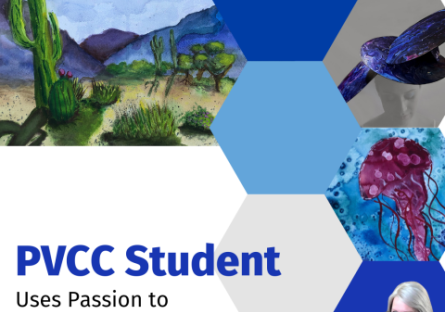
For Melinda Villela, life has thrown her many curve balls. But through sheer determination and the will to move forward, Villela is using her passion for art to heal from personal tragedy.
At a young age, growing up in the Midwest, she not only lost her dad at three years old, but also learned she had a vision disorder that would eventually leave her blind. Retinitis Pigmentosa is an inherited degenerative disorder that affects the retina’s ability to respond to light. The result is progressive loss of vision.
Villela said she managed the disease for decades, having a successful career working for the Arizona Commission for the Deaf and the Hard of Hearing. However, in 2013, she was deemed legally blind and although her agency made accommodations for her, the work was high profile and demanding, and she made the hard decision to take medical retirement two years later when tragedy struck again.
Battling bipolar disorder, Villela’s 25-year-old son died by suicide in 2015 and left her and her family reeling. It was then that Villela took comfort in her art. She had promised herself that in retirement she would begin painting. Villela and her family sought comfort and guidance at Billy’s Place, a safe community for kids and their families experiencing grief. A mere two weeks after her son’s death, they attended a Survivors of Suicide conference and one of the activities happened to be painting a picture. It was at this moment that the next chapter of her life began.
“I had painted a dark purple background and a black tree,” she described. “It looked like a third grader did it. But as I stood up to talk about the significance of the painting and the events that had occurred only two weeks before, people rallied around me, astounded that I was even there. It was an incredible feeling.”
There were many sleepless nights for Villela as she moved through her grief. During those sleepless hours, she would follow art tutorials online with Cinnamon Cooney - The Art Sherpa, finding solace in her strokes.
“She made me believe I could paint. It gave me something I could put my hand to and my mind to. I truly became a believer in the healing power of art,” she continued.
In the month’s after her son’s suicide, Villela took comfort in volunteering at the Arizona Center for Blind and Visually Impaired in the ceramics department working alongside the organization’s revered, terminally ill social recreation director.
“I walked with him as he worked as long as he could work,” she said. “And I helped keep the community services going until they found a full time replacement. That’s when I decided I was ready for something more. That I wanted to become an art therapist.”
According to the American Art Therapy Association, art therapy is an integrative mental health and human services profession that enriches the lives of individuals, families, and communities through active art-making, creative process, applied psychological theory, and human experience within a psychotherapeutic relationship. It is used to improve cognitive and sensorimotor functions, foster self-esteem and self-awareness, cultivate emotional resilience, promote insight, enhance social skills, reduce and resolve conflicts and distress, and advance societal and ecological change. Facilitated by a professional art therapist, art can effectively support personal and relational treatment goals as well as community concerns.
PVCC Art Faculty and Program Director Adria Pecora, who has been Villela’s instructor for several years, describes her “as an inspiration to all PVCC Art faculty.”
Villela will graduate in December with a degree in Fine and Performing Arts, and plans to continue her studies at Arizona State University and earn her bachelor’s in Interdisciplinary Science, and eventually, her master’s in Art Therapy.
“My dream is to create a mobile art therapy studio in the back of a toy hauler and travel across the country, partnering with non-profit organizations helping trauma victims, veterans and survivors of suicide.”
The support groups she and her family have been part of over the past six years have been monumental in their journey. Today, Villela and her husband, a 20-year Arizona state trooper, volunteer as facilitators of a traumatic loss group at Billy’s Place.Her son’s daughter, who was four when he died, is now training to be a ‘Billy’s Buddy’ (peer mentor) as well.
Depression affects 20 to 25 percent of Americans ages 18+ in a given year, according to the Centers for Disease Control. It is the 10th leading cause of death in the US for all ages. If you or someone you know needs assistance, contact the National Suicide Prevention Life Line.If you are grieving the loss of a loved one and need support, contact Griefshare.org.